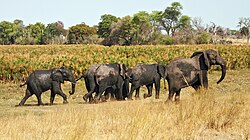Search results
Appearance
There is a page named "Zambezi Region" on Wikipedia
- The Zambezi Region, known as the Caprivi Region until 2013, is one of Namibia's fourteen regions, situated in the north-eastern part of the country along...20 KB (2,100 words) - 13:32, 3 July 2025
- The Zambezi (also spelled Zambeze and Zambesi) is the fourth-longest river in Africa, the longest east-flowing river in Africa and the largest flowing...67 KB (7,015 words) - 12:44, 1 February 2025
- Zambezi expedition)for new mission stations north of the Zambezi and his wider object of opening the interior for trade via the Zambezi, was not enough to make him resign from...104 KB (12,225 words) - 00:09, 7 July 2025(category Constituencies of Zambezi Region)Linyanti Constituency is located in Namibia's Zambezi Region. The constituency derives its name from the Linyanti River. It has a population of 10,425...6 KB (516 words) - 12:58, 8 September 2024
- Sankwasa James Sankwasa (category People from Zambezi Region)2020. Sankwasa was born on 5 May 1955 in Sikanjabuka district in the Zambezi Region. He holds a master's degree in business administration from Thames Valley...3 KB (224 words) - 19:58, 29 May 2025
- by a split of Kavango Region (which was named Okavango before 1998). At the same time, Caprivi and Karas were renamed Zambezi and ǁKaras, respectively...3 KB (219 words) - 08:39, 31 March 2025
- Subia people (category Zambezi Region)"A study of Sipelu music and dance among the Masubia people of the Zambezi region of Namibia". Retrieved 8 May 2022. "Unam appoints Kenneth Matengu as...19 KB (2,729 words) - 14:11, 2 July 2025
- Luhonono (category Populated places in the Zambezi Region)about 800. It belongs to the Kabbe North electoral constituency of the Zambezi Region. During the time of German colonialism, it was the capital of the Caprivi...10 KB (761 words) - 15:52, 17 October 2024
- Cuando River (category Geography of Zambezi Region)Linyanti River and, farther east, the Chobe River, before it flows into the Zambezi River. The Cuando rises in the central plateau of Angola on the slopes...9 KB (732 words) - 14:58, 14 June 2025
- Katima Mulilo (category Populated places in the Zambezi Region)Katima Mulilo, or simply Katima is the capital of the Zambezi Region in Namibia. It had 46,401 inhabitants in 2023, and comprises two electoral constituencies...27 KB (2,386 words) - 09:06, 9 July 2025
- Kabbe Constituency (category Constituencies of Zambezi Region)Kabbe was a constituency in the Zambezi Region of Namibia. Most of the area is situated in the flood area of the Zambezi River. It contained the former...4 KB (283 words) - 00:25, 14 February 2025
- Mubiza, Namibia (category Populated places in the Zambezi Region)the Zambezi Region of Namibia, east of Katima Mulilo, the capital of the Zambezi Region. Mumbiza is north of Botswana, and south of the Zambezi River...4 KB (73 words) - 13:39, 19 September 2021
- Bwabwata National Park (category Zambezi Region)Namibia's Caprivi Game Park and Mahango Game Park. It is situated in the Zambezi and Kavango East regions, extending along the Caprivi Strip. It is bounded...14 KB (1,554 words) - 20:16, 23 June 2025
- Lawrence Sampofu (category People from Zambezi Region)He was the governor of Zambezi Region from 2010 to 2025. Sampofu was born on 10 August 1955 in Mbabanzi in the Zambezi Region. During Namibia's struggle...1 KB (130 words) - 19:24, 1 July 2025
- Zambezi River and Region 36304The New Student's Reference Work — Zambezi River and Region Zambezi (zȧm-bā′ zē) River and Region, the extensive region
- down into a large rent which had been made from bank to bank of the broad Zambezi, and saw that a stream of a thousand yards broad leaped down a hundred
- just to the north of them, Lobengula's domains. The fact that the Zambezi–Limpopo region did not fall into any of the "spheres of influence" defined at the










